What if a product that’s meant to bring extra comfort to sex, actually hurts your intimate tissues?! Sadly, many personal lubricants’ ingredients both disrupt vaginal flora and correlate with anal tearing and infection risk. In contrast, the best 💦 lubricants are pH balanced (to either the vagina or the butt); & iso-osmotic, meaning they don’t demolish your vaginal / anal cell structures (which protect against bad bacteria & viruses!). After I endured a painful 😧 vaginal infection this year, I’d had enough—it was time to find the whole truth about lubricant safety. This guide details lubricant osmolality & lubricant pH, with exact measurements!
I took scientific measurements on 52 commercial lubricants, so you don’t have to buy expensive lab equipment! Skip ahead here to the quick recap. Water-based lubricants require care to choose a safe, balanced option. Meanwhile, silicone and oil-based lubes don’t have either pH or osmolality: But do carry other potential issues.
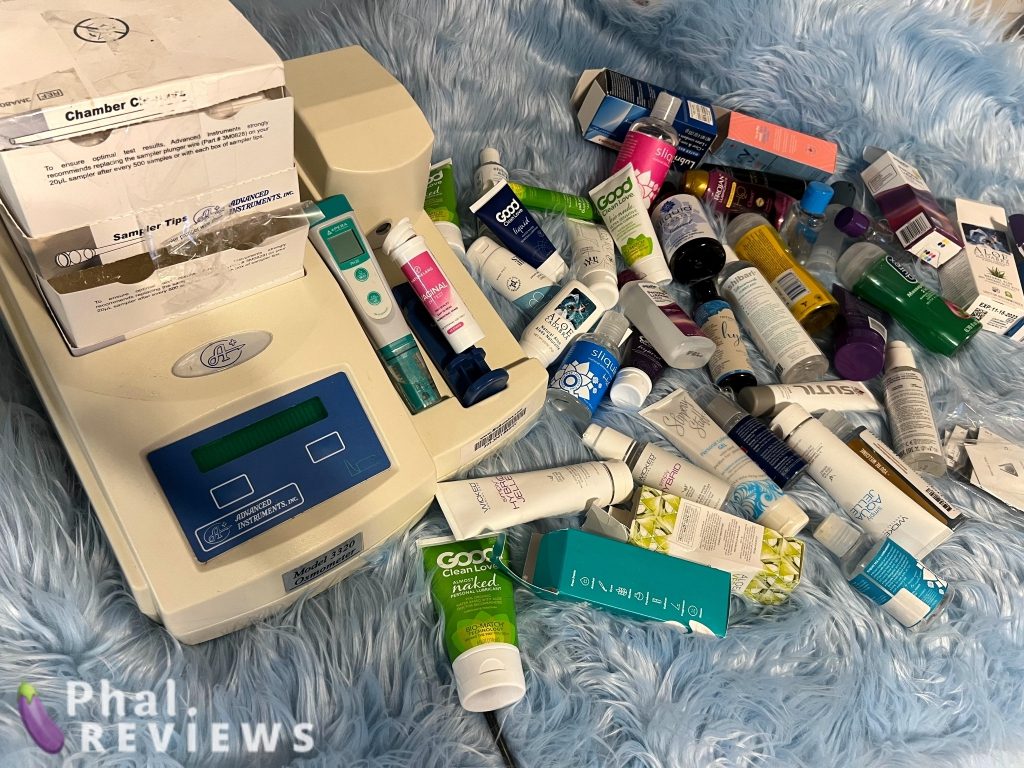
This balanced sex lubricant guide will recap the pros & cons of water-based, hybrid, silicone, and oil-based lubricants. I’ll explain, “What is ‘osmolality,’ and why does lubricant pH matter?,” then I’ll give my independent pH and osmolality ratings for the aqueous lubes, talk about coconut oil safety, and how to choose an anal lubricant too!
Contents
Safest Sex Lubricants, by Type
After months of in-depth research and scientific testing, I recommend the following lubricants as the best way to safeguard your vaginal microbiome or your rectum. It’s not all bad news, either: Good lube (1) safeguards your tissues against the friction of sex, especially large or fast penetration; and (2) makes sex toys feel much more cushy. See my list of medical studies for a detailed dive. Note: The vagina and the rectum have different healthy pH levels, so it’s impossible to find a water-based lube that’s pH matched to both holes at once. See these icons below to mean: 🌺=vulva & vagina-friendly, 🍑for anal use, & 🍆for the penis by itself:
- 🌺Best water-based lubricant for vag: Almost Naked (thicker aloe base; vanilla scent) or BioNude (unscented) by Good Clean Love
- 🌺Best water-based in most sex toy stores: Sliquid H2O (not Sliquid Sassy)
- 🌺Best hybrid lubricant (for vaginal use): Good Clean Love Hybrid
- 🍑Safest anal lubricants: Pure oil-based like Coconu or coconut oil; or silicone if silicone toys aren’t being used.
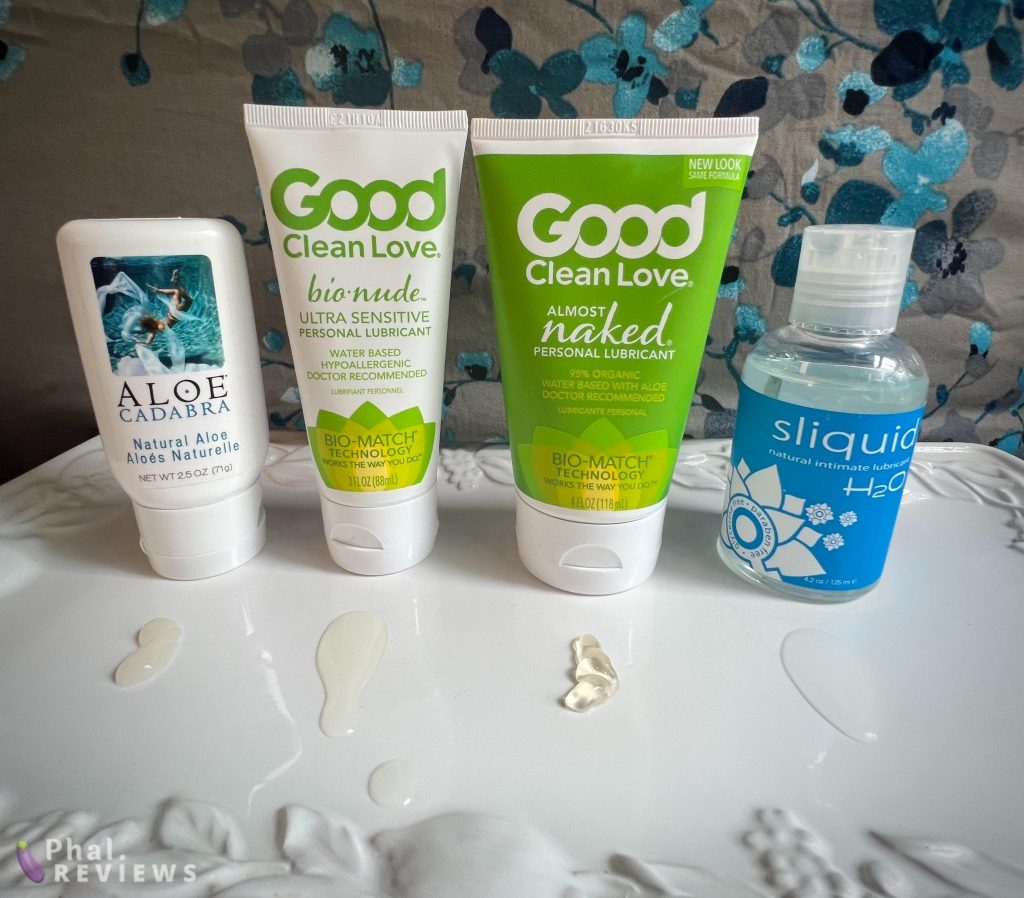
There are four types of lubricants, with these pros & cons:
- Water-based lubricants:
- ✅Can feel the most “natural,” imitating natural wetness.
- ✅Easiest to clean up.
- ❌Shop carefully: These lubes require preservatives and thickeners; the wrong ingredients can damage your protective cell barriers and/or disrupt pH.
- ⭕Rarely pH-balanced for anal play.
- Hybrid lubricants:
- ✅Added silicone makes a hybrid’s water base last longer.
- ✅It sticks to toys better, and is great for high-texture sex toys like fantasy dildos.
- ✅Easier cleanup than oil-based and silicone lubes, and doesn’t stain sheets.
- ✅Won’t affect silicone toys.
- ❌Also has the same issues with preservatives, etc. that can be disruptive.
- ⭕Also usually pH-balanced for vaginas, not for anal sex.
- Oil-based lubricants:
- ✅The longest-lasting slickness.
- ✅Great for anal stretching & jerking off: or any high-friction play.
- ❌Can stain sheets. (Put down a towel or waterproof blanket.)
- ❌Don’t use with latex or polyisoprene condoms.
- ❓No 100% consensus that coconut oil is totally safe for vaginal use.
- Silicone lubricants:
- ✅Also quite long-lasting, and less greasy than oil.
- ✅Has no pH nor osmolality, so it won’t disrupt either the anal or vaginal microbiome.
- ✅Safe with all condoms.
- ⭕May harm some silicone sex toys.
- ❓Might take longer for the vagina to self-clean this lube out, so don’t apply huge amounts vaginally.
Read why Amazon-bought lubes may be unsafe here. I’d like to give a huge thanks to Peepshow Toys🎉 for donating most of the lubricants tested: For science!!!
Lubricant pH & Osmolality – Why Do We Care?
The vagina and rectum both have their own natural balance: they’re separate microbiomes, mini “ecosystems” within the human body. And the vast majority of commercial lubes are not correctly formulated to match one or both of: pH and osmolality, for either the vagina or the rectum/anal canal. Generally, glycerin in lube, propylene glycol in lube, and propanediol in lube aren’t optimal.
Hybrid and water-based lubricants can hurt your body when:
- They force your tissues to push out water.1 This happens with high osmolality (hyperosmolal / hyperosmotic) lubricants. These concentrated lubes separate or “slough off” the protective epithelial barriers, “caus[ing] the cells to shrink and shrivel.”
Imagine it like this: The 4 layers of the vaginal epithelium (protective skin barrier) are made of different substances: sticks, straw, and bricks.2 But, the Big Bad Wolf coming to knock down these building materials is actually a force of wind and water too: a hurricane, if you will.

The more hyperosmolal a lubricant is, the higher the “wind speed” produced by this aqueous assault. As a range of studies have shown,3 deeper-tissue damage correlates strongly with high osmolality. And also see Fuchs et al.’s info4 on how high-osmolal lubes hurt during anal application:
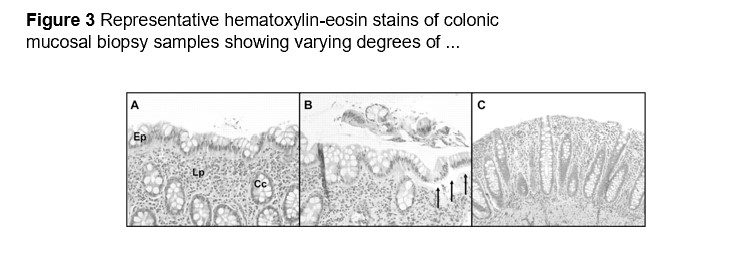
Now, while I think “colonic crypts” would be a great goth-metal band name, I wouldn’t want those exposed inside my body!
So how do we avoid harmful lube effects? Let’s look at lubricant safety guidelines the World Health Organization released a decade ago, in re optimal lubricant osmolality and pH for water-based lubes:
- “Ideally, the osmolality of a personal lubricant should not exceed 380 mOsm/Kg to minimize any risk of epithelial damage. Given that most commercial lubricants significantly exceed this value,… it is therefore recommended on an interim basis that [sexual health] procurement agencies should source lubricants with osmolalities of not greater than 1200 mOm/kg.”
- “The pH of the healthy vagina is normally in the range 3.8–4.5. The pH of the rectum is closer to neutral (pH 7). High vaginal pH can lead to an increase in the risk of bacterial vaginosis. High pH is also more supportive of HIV survival. Ideally therefore a vaginal lubricant should have a pH of about 4.5 and a rectal lubricant of about 5.5 to 7. It is unfortunate that these optimum requirements cannot be bridged in a single lubricant.”
It’s a problem because for decades, water-based personal lubes have been based on hyper (high)-concentration ingredients. As my test results below show, 98% of the time it’s bad news when any of the following 3 chemicals is a main lubricant ingredient:
- Glycerin or glycerol, a sugar alcohol.
- Propylene glycol (1,2-propanediol).
- Propanediol (1,3-propanediol), propylene glycol’s close relative. (Both have two alcohol groups in their chemical structures.)
So why are problematic lubes still sold?! Well, lubricant safety is a science that’s boomed over the last 20 years. In the past, the FDA has required lube toxicity testing on rabbit and/or guinea pig vaginas, which are very different from human ones; while safety trials on real-live human beings may be regarded as unethical. Plus, “hyperosmolal lubricants cause little or no obvious pain or discomfort to most users. But they cause marked toxicity to the human colorectal epithelium,… increase susceptibility to genital herpes (HSV) infections… and they cause obvious toxic effects in the slug mucosal model.”5
Scientists who discuss lubricant safety point to the case of nonoxynol-9: a spermicide allowed in lubricants for almost 50 years until researchers realized that frequent nonoxynol-9 users were twice as likely to acquire HIV.6 Yikes!!!
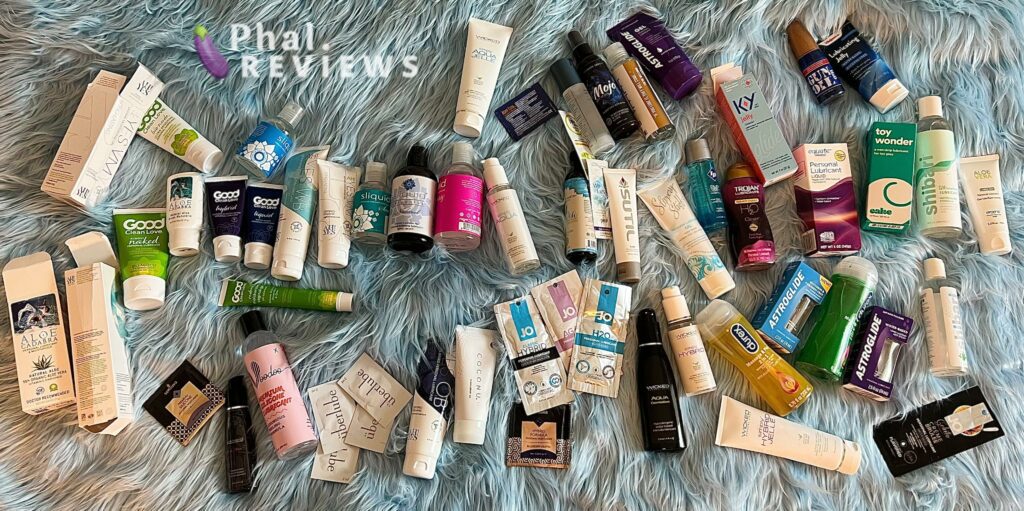
pH & Osmolality Lubricant Ratings
This list applies to water-based lubricants mainly, with some hybrid (water-based + silicone) lubricants appearing too. Silicone lubricants and oil-based lubricants don’t pose pH balance or concentration safety issues, and they don’t usually contain harmful additives like the parabens some water-based lubes still use. (Read more on the downside of silicone lube here & oil+condom incompatibility here.)
| Lubricant | Osmolality (mOsm/kg) | pH Level |
|---|---|---|
| Ideal Results: | ≈150–450 ✅; Under 50 😐; 1,200+ is damaging. | 3.8–4.5 for vag; ≈6–7 for butt. |
Safe for vag/vulva⬇️ | ||
| Almost Naked by Good Clean Love | 282 | 4.5 |
| BioNude by Good Clean Love | 276 | 4.4 |
| Liquid by Good Clean Love | 270 | 4.4 |
| Ah Yes! WB | 169 | 4.4 |
| Aloe Cadabra | 164 | 4.4 |
| Sliquid H2O | 144 | 4.2 |
| Please GEL by Good Vibes (Good Vibrations) | 128 | 4.5 |
| Hybrid by Good Clean Love | 367 | 4.2 |
Vag moisturizers⬇️ | ||
| Ah Yes! VM | 275 | 4.0 |
| Restore by Good Clean Love | 268 | 4.1 |
A lil too watery, but might be OK for vag.⬇️ | ||
| Sliquid Sea | 93 | 4.1 |
| Sliquid Organics Natural | 94 | 4.4 |
High Osmo., but Not *Really* High⬇️ | ||
| Sliquid Silk hybrid | 686 | 4.4 |
| Sliquid Sassy | 763 | 4.5 |
| Trojan H2O Closer | 588 | 6.0 🍑 |
Over max. limit by World Health Org.⬇️❌ | ||
| Please Cream (hybrid) by Good Vibes (Good Vibrations) | 1248 | 4.7 |
| KY Jelly Classic | 1258 | 4.0 |
| Simply Aqua by Wicked | 1761 | 4.9 |
| Durex Massage & Play, 2 in 1 with ALOE | 1813 | 4.0 |
| LubeLife | ≈2,225 | 4.0 |
| Shibari Ultrasmooth Lubricant | ≈2315 | 3.9 |
| Sutil Luxe Glide | ≈2335 | 4.3 |
| WaterSlide by Earthly Body | ≈2253 | 7.3 |
| Walgreens Lubricating Jelly | ≈2368 | 5.1 |
| Liquid Silk (not Sliquid) | ≈2290 | 5.7 |
Extra high-osmo.⬇️❌ | ||
| Jo Agape | ❌ = over 2,500 | 4.0 |
| Lola Personal Lubricant | ❌ = over 2,500 | 4.2 |
| Sensuva Hybrid | ❌ = over 2,500 | 4.2 |
| Durex Massage & Play, 2 in 1 with Ylang-Ylang | ❌ = over 2,500 | 4.3 |
| Toy Wonder by Cake | ❌ = over 2,500 | 4.4 |
| Mojo Water-Based Glide with Peruvian Ginseng by Intimate Earth | ❌ = over 2,500 | 4.5 |
| We-Vibe Lube by Pjur | ❌ = over 2,500 | 4.5 |
| Simply Aqua Jelle by Wicked | ❌ = over 2,500 | 4.7 |
| Simply Hybrid Jelle by Wicked | ❌ = over 2,500 | 4.9 |
| Simply Hybrid by Wicked | ❌ = over 2,500 | 5.0 |
| Intimate Earth Hydra | ❌ = over 2,500 | 5.0 |
| Equate Personal Lubricant by Walmart | ❌ = over 2,500 | 5.0 |
| "Shibari Aloe" "Aloe-Based Lubricant" | ❌ = over 2,500 | 5.0 |
| Swiss Navy water-based | ❌ = over 2,500 | 5.0 |
| Jo Gelato Flavored lubricant | ❌ = over 2,500 | 5.8 |
| Pjur Med Repair Glide | ❌ = over 2,500 | 6.0 |
| Jo Classic Hybrid | ❌ = over 2,500 | 6.6 |
Hazardous ingredients⬇️🛑 | ||
| Astroglide Gel (w/ bactericide, parabens, and lye) | ❌ = over 2,500 | 4.4 |
| Astroglide Glycerin & Paraben Free Liquid | ❌ = over 2,500 | 4.4 |
| Astroglide Water-Based Liquid | ❌ = over 2,500 | 4.5 |
| Aqua Lube from Planned Parenthood (w/ Paraben) | ❌ = over 2,500 | 4.2 |
| Gun Oil H2O | ❌ = over 2,500 | 5.9 |
| ID Glide | ❌ = over 2,500 | 5.4 |
| Jo H2O | ❌ = over 2,500 | 6.5 |
| Wicked Aqua Sensitive | ❌ = over 2,500 | 5.1 |
PEO-based = Sticky & Stringy! | All r hypo-osmolal if pre-prepared; X-Lubes gets hyper-osmolal the more powder is added. | These lubes are pH-balanced for anal, not vaginal use. |
| Bad Dragon Cum Lube | 111 | 6.9 |
| Slippery Stuff | 21 (quite low) | 7.0 |
| J-Jelly (vetinary lube, technically!) | 68 | 7.1 |
| Bad Dragon Clear Cum Lube | 55 | 7.4 |
| X-Lube powder | 25 to 45 | 7.4 to 7.8 (tested on 1 cap & 2 caps dumped into 16 oz. water; prepared as per manufacturer's instructions) |
| J-Jelly (vetinerary lube, technically!) | 68 | 7.1 |
| Other | ||
| Intimate Earth Defense: Contains antimicrobial tea tree oil: Might harm GOOD vag bacteria | 236 | 4.2 |
Hit the arrows on the right side, or [2] or [3], to see all the unbalanced lubricant options. Or, see this note for a full list of lubes included.7
Find a full list of each lube’s ingredients, and discussion of problem ingredients, in this post.
All lubricants were either: (1) donated by the body-safe retailer Peepshow Toys; (2) purchased by myself; (3) donated by an awesome friend of mine: thanks, K.! (Planned Parenthood lube, Jo lubes, and the We-Vibe Pjur sample pack I’ve always thrown away in the past); or (4) (for Good Clean Love Hybrid & Liquid only) sent to me by Good Clean Love. And I, Phallophile (a.k.a. Felicity), purchased an Advanced Instruments 3320 scientific-grade osmometer, sampler tips for said osmometer,8 an electronic pH tester kit, and other pH test strips because I believe we have the right to know exactly what we are putting in our bodies. You shouldn’t have to pay $1,000 to know whether your sex lube is safe.
If you’d like to support my research, please donate to Phallophile Reviews on Ko-Fi, as I’d be happy to add other lubricants people are curious about. Lubricant osmolality tests were rerun 3 to 5 times for lubes with strange results, like Sliquid Sassy being higher than expected, Trojan’s glycerin lube being lower than expected, and Slippery Stuff slippery-ing all over the sampler tip.
VAGINAL & VULVA LUBES: Top Choices
Good Clean Love Lubes Compared
Good Clean Love (GCL) has 4 lubricants now, and all are iso-osmotic, balanced to match vaginal fluid concentrations; and pH-balanced for vaginas—but each one is a lil different in consistency. All GCL lubes include lactic acid, which is naturally found in vaginas dominated by healthy Lactobacillus bacteria; whereas the citric acid found in other water-based lubes is not a normal part of the vaginal microbiome.
- Almost Naked is the original, and the most-studied for safety. It’s an organic aloe vera base that’s thicker. It includes vanilla scent, which you might either love (my partner does), or be put off by. It does feel more “gel-like,” and is very padded when you start moving a toy. I prefer this one because it has less ingredients.
- BioNude is a more synthetic formula, based on plant cellulose. It’s a little thinner, more in line with “normal” lubes, and has a couple other plant ingredients like carrageenan (originally derived from seaweed) and carob.
- Liquid does have propanediol as its 4th ingredient, but remains in a safe osmotic range. It feels very similar to BioNude, but with slightly more longevity; coats toys well. Vs. BioNude, Liquid adds hyaluronic acid, which human skin tissue contains naturally; this synthetic version is here for more slickness.
- Hybrid is a silky water+silicone blend, that I would recommend on veiny or heavy-texture silicone sex toys. This creamy water+silicone blend manages to include (less than 1%) of both propanediol and glycerin, yet maintains an osmolality of 367 mOsm/kg vs. Sliquid Silk’s 686. (GCL Hybrid is 87% less concentrated.) If you are uber-sensitive to glycerin, you might still opt for Silk.
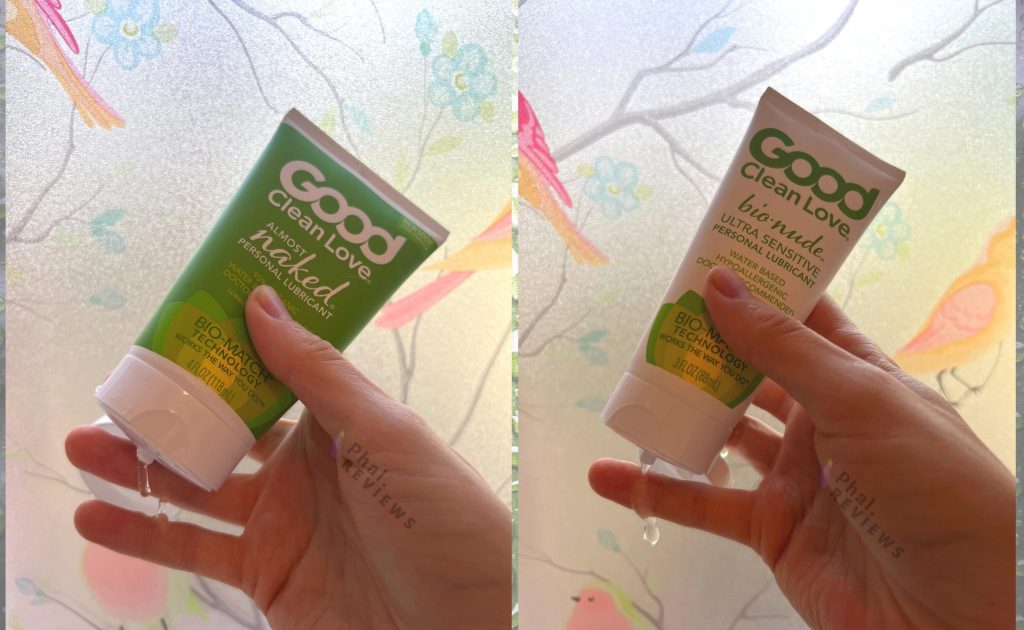
Sliquid H2O: Better-Balanced Than Sliquid Sassy
Sliquid H2O is the closest match to natural water balance, among all Sliquid water-based (and hybrid) lubricants. This means Sliquid H2O is the safest option you’ll hopefully find when purchasing sex toys, since most shops carry Sliquid.
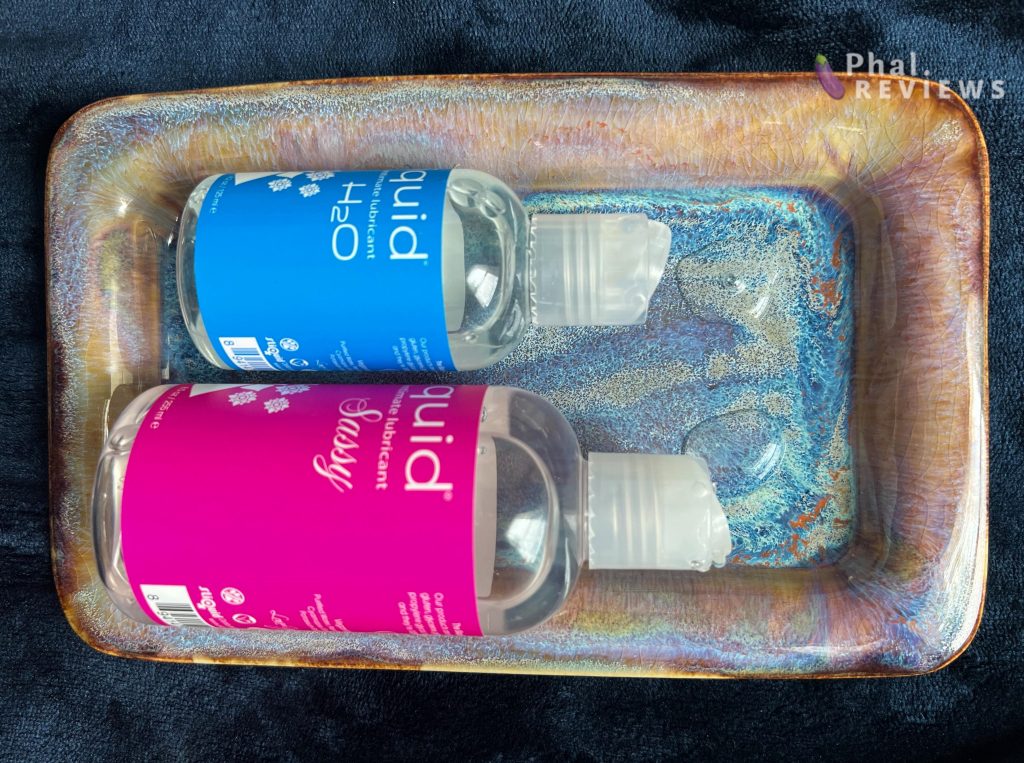
I tested Sliquid H2O and Sliquid Sassy several times each, and H2O lubricant’s osmolality remained in the 100–150 range, while Sassy scored at 763 mOsm/kg: That means Sassy’s over 5 times as concentrated as H2O even though their labels have the very same ingredients on them! Much more plant cellulose is employed to create Sliquid Sassy, clearly. Sassy comes out as more of a gel, vs. H2O’s more watery consistency.
Silicone Lube (Uberlube, etc.): For Penetrative Sex
Uberlube is a favorite silicone lube: 2 pure silicone ingredients, plus vitamin E (which adds shine to the skin). If you’re not into vitamin E feeling more oily, then see Sensuva’s silicone lube with 3 silicone-based ingredients. All pure silicone lubes require no preservatives, nor do they have osmolality or pH problems.
A few drops make sex much slicker, and a bottle can easily last 6 months to a couple years. (5-year shelf life plus!) I would use silicone lube for everything *if* it didn’t interact with silicone sex toys (more on that, next), so now I just use it for long rides when my partner’s up for it, or with glass sex toys.
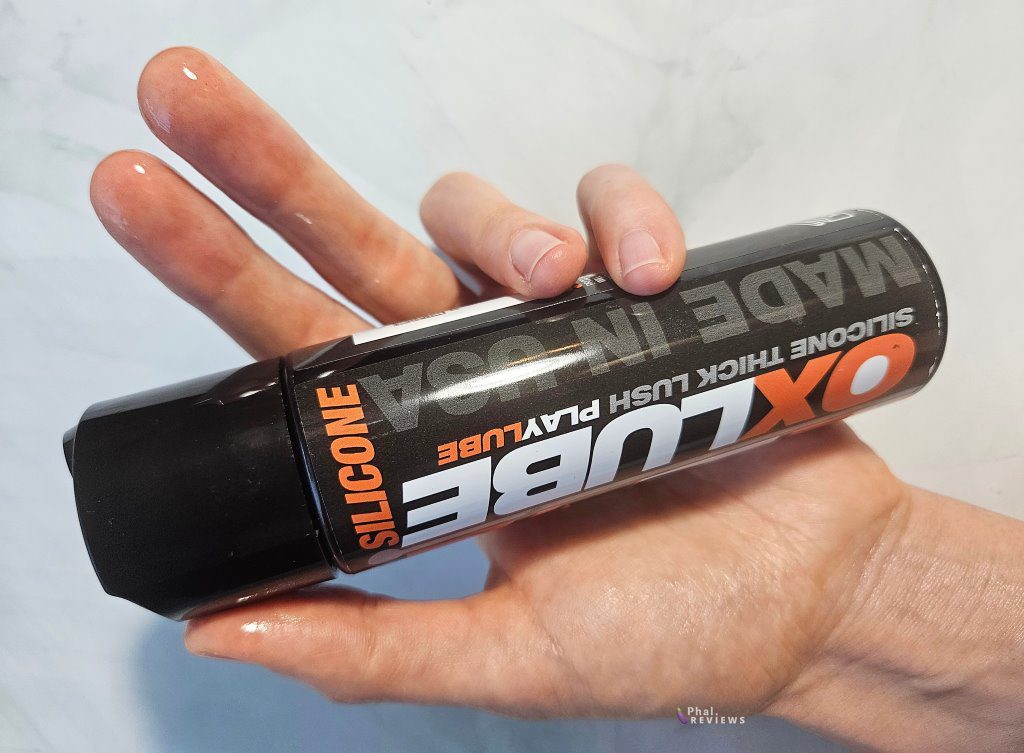
Only problem with silicone lubricant: It’s tough to clean off silicone sex toys (lots of scrubbing 🧼🤲), and in the case of silicone-coated vibrators, it can alter the surface of the material or void the warranty; details here.
Aloe Cadabra
Aloe Cadabra is a lovely, thick aloe product with vitamin E. It does tend to glob up more as you move toys around, so reapplication is encouraged. However, it’s more expensive for a 2.5-ounce tube than you’d pay for a 4-ouncer of GCL Almost Naked, and Aloe Cadabra seems to absorb faster.
ANAL LUBES: Top Choices
So slicker is definitely better for anal play, especially when it includes thrusting. The rectum may be even tighter (than the vagina), so you want to pad the tissues to avoid “micro-tears”—tiny cuts to the tissues inside your asshole, ouch!
For serious anal, non-water-based options tend to be more popular, since (1) water-based will dry out faster and (2) water-based lubes usually are acidic, so they don’t match the rectum’s pH and might sting if you’re sensitive. So that leaves us with these thick anal lubricants:
- Oil-based lube is best for long-term butt plug wear. And popular with silicone sex toys overall, since it won’t affect silicone. Very, very slick, so it’s ideal for stretching, minimizing friction during pegging, and more. Top picks: Coconu for easier, less-messy application; or virgin coconut oil from the grocery store for lots of slide for cheap.
- Silicone lubricant makes sense for penis-in-anus sex; for non-silicone toys like the Pure Wand, an intense prostate tool; and for any anal sex involving condom use. Silicone lube is oily in a good way, moisturing, and a little goes a long way. Top pick: Oxlube, 3 silicone ingredients, real smooth & US-made.
- PEO-based lubes like Bad Dragon lubes & X-Lube / J-Lube / K-Lube are very popular for anal because they are so slick & just stick, stick, stick: the polyethylene oxide (PEO) is the reason. I recommend Bad Dragon’s Clear Cum Lube first in this category for anal, over powdered “make it your own lubricants” because you’ll avoid clumping & lubes that require more work to clean. Do not use Bad Dragon Cum Lube or X-Lube, etc. for vaginal use, the pH is too high.
Coconu Oil-Based: Anal & Stroking Lube
Coconu advantages over coconut oil:
- Squeezes on, doesn’t drip on. You don’t need to dig out a spoon to apply Coconu, like you need a clean spoon to dip into a jar of coconut oil kept at room temp. This makes Coconu faster “in the heat of the moment.”
- I thought it was a little easier to clean up, too. Coconut oil can get into toy cracks and such, but we used it on my bf’s new rumbly butt plug recently, and he washed the Coconu right off, no streaks or anything left behind. I didn’t expect that!
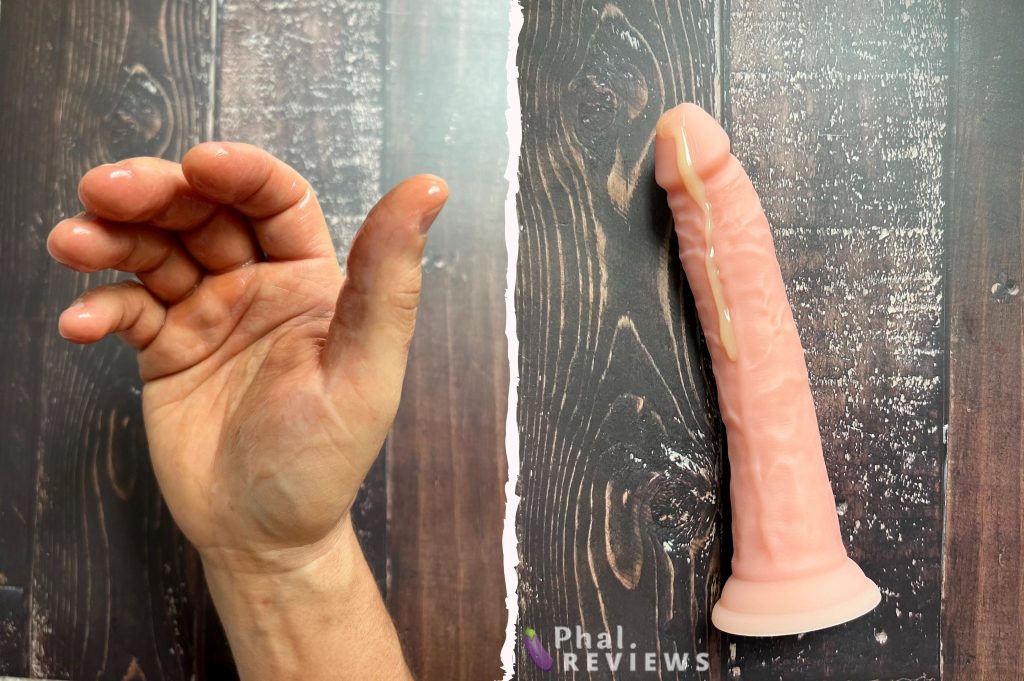
So my boyfriend definitely likes Coconu’s feel better than coconut oil. He thinks Coconu feels “silky” on the skin, even after he washed his hands; vs. coconut oil having “a gummy feeling after a while.” I found that the Coconu lasted well for a short but hard stroking session; and then after we moved on to me, it needed a small additional squeeze-dollop for him to continue the slick-stroking later. (We also tried an oil blend by Ah Yes!, with less enthusiastic feedback!)
Oil-Based Lubricants Cleanup
Oil is popular because it lasts… which also means it sticks around more when you’re washing a toy off: Though I’ve found silicone lube on silicone toys the worst to clean up, coconut oil is a close second. (If you have bedsheets you’re fond of, also definitely put down a towel or waterproof blanket when applying coconut oil via spoon.) Do wash your coconut-oiled-up toys really well after you’re done with them, scrub with soap and water for several minutes! Coconut oil’s lipids really stick. Leading to potential storage issues: If a silicone toy was used with coconut oil (but some oil remains on the surface), and then the toy is stored in a warm storage locker, which then cools to freezing temps, a chrystalline structure can form on the silicone. People who use coconut oil on their toys, clean them, and then put them in a storage locker for months will then find this white stuff on the toys and be like, “What is this? I thought silicone didn’t mold???” (Because they interpret the coconut crystals as a strange fungus of some sort.) Nope, just wash it better!
Bad Dragon Cum Lube vs. X-Lube, J-Lube, etc.: Polyethylene Oxide!
Two final, popular choices for anal: 1) Bad Dragon’s Cum Lube, vs. 2) X-Lube and its friends J-Lube and K-Lube. I’m grouping these together since they’re all based on water added to polyethylene oxide (PEO).
Bad Dragon’s Cum Lubricant has the safest osmolality: a bit over 100 mOsm/kg, which is a bit low yet not low enough to be damaging.9 And, unlike almost all other water-based lubes, Cum Lubes (and all PEO lubes I’ve tested!) are the same pH as the rectum! They’re not acidic. So, you’d probably want to use a Cum Lube within 3–6 months (acidity leads to better preservation), but they won’t sting upon application. I recommend Clear Cum Lube first, though: it’s got a lower osmolality but doesn’t contain titanium oxide: the scientific jury is out on whether titanium dioxide, ingested, can cause DNA damage or increased risk of cancer; there’s enough concern that the European Commission began banning it as an additive in 2022. See titanium dioxide in my ingredients of concern section for more.
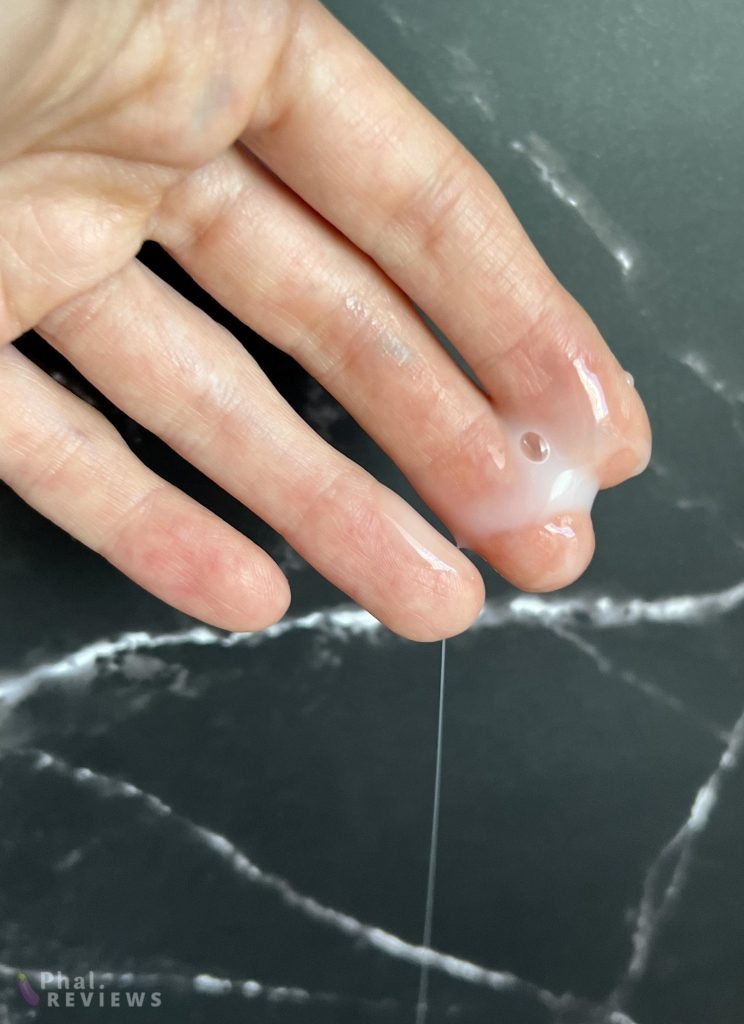
That’s versus X-Lube, J-Lube, and K-Lube, widely used for big anal / hardcore anal because they are so damn slick. They hang around, too: Hard to cleanup and wash off!!! X-Lube is pure PEO, while J-Lube has sucrose added, and K-Lube has some kind of undisclosed preservative.
More Lubricant Safety Notes 🛑
- Don’t buy your lubes off Amazon. Case in point: I bought two bottles of Sliquid Sea this year off Amazon, for the fast delivery. I thought, “I definitely wouldn’t buy sex toys off Amazon, but the lubes might be OK….” And, NOPE. The concentrations of these Amazon-bought lubricants were vastly different than the one I received from an authorized distributor (thanks, Peepshow Toys!). The Sliquid Sea distributor lube tested at 93 mOsm/kg, like Sliquid Organics Natural lube and close to Sliquid H2O; while the Amazon bottles tested at 54 and 765 mOsm/kg, respectively. What a difference! I threw those two Amazon bottles away after I saw how extra-concentrated one of them was; the storage conditions must be really bad.
- “Natural ingredients” doesn’t necessarily mean “better.” Watch out for BS marketing here: Companies who want you to assume their high-concentration lubes are healthy because of “plant derived glycerin,” “botanical source[s],” “all natural,” or “with aloe” when aloe is waaaay down the ingredients list, etc. Now, organic aloe-vera gel is an awesome, safe lubricant base.10 But beyond that, there’s no reason to include a laundry list of plant extracts in a sex lube. Why? Because the vagina didn’t evolve to absorb an array of plant stuffs:
Is Coconut Oil Safe for Vaginal Use?
As a best practice, I can recommend (virgin) coconut oil for anal play, but I will not use it vaginally. The literature is inconclusive about whether the lipids (fats) from coconut oil can be easily cleaned out by the vagina; and whether coconut oil’s antimicrobial properties affect the vaginal microbiome either negatively or positively when used regularly as a sex lube.11
We just don’t know on a wide scale if coconut oil will mess up vaginal health—and, as always, some people will be more susceptible to infections (bacterial pathogens [as in BV], urinary tract infection, yeast, etc.) than other people. Anecdotal reports will definitely have some people with vaginas, even ones prone to yeast infection, who don’t feel bothered by coconut oil. So, you may choose to use coconut oil vaginally, based on your risk-aversity level. Coconut oil as a lubricant is safer than vaseline and petroleum oils, at least!
NOTES
First, I’d like to apologize for all the times I promoted Sliquid Sassy, and then Wicked Simply lubricants, over the past 5 years—assuming, because of their “natural” labeling and lack of glycerin, that they’d be very safe.
- In an effort to correct for the over-concentrated solution outside.
- The inner layer, the basal layer, is the most “block like,” and crucial for health because it generates new cells. Latent viruses like HPV take advantage of that fact by integrating into the basal cells after the “superficial” or “apical” cell layers are broken through.
- See especially Fig. 2 in Ayehunie, Seyoum, et al., “Hyperosmolal vaginal lubricants markedly reduce epithelial barrier properties…,” in Toxicology Reports 5 (2018): 134–140.
- Figure 3 from Fuchs, Edward J., et al., “Hyperosmolar sexual lubricant causes epithelial damage in the distal colon…” in Journal of Infectious Diseases 195, no. 5 (March 2007): 703–10.
- Emphases added. Quotation from Ayehunie et al., “Hyperosmolal vaginal lubricants markedly reduce epithelial barrier properties…,” in Toxicology Reports 5 (2018): 134–140; this is a fantastic intro to lube safety from a very conclusive study. See my list of top science to read about lube osmolality here.
- See in particular Happel, Anna-Ursula, et al., “Considerations for Choosing Soluble Immune Markers to Determine Safety of Novel Vaginal Products,” in Gynecology, a section of Frontiers in Reproductive Health (May 2022), section “The Cautionary Tale of Nonoxynol-9.”
- Good Clean Love Almost Naked osmolality and pH; Good Clean Love BioNude lubricant osmolality and pH; Good Clean Love Liquid osmolality and pH; Good Clean Love Hybrid osmolality and pH; Yes! WB lubricant osmolality and pH; Aloe Cadabra osmolality and pH; Sliquid H2O osmolality and pH; Good Vibrations Please Gel osmolality and pH; Good Clean Love Restore moisturizer osmolality and pH; Ah Yes! VM osmolality and pH; Sliquid Sea osmolality and pH; Sliquid Organics Natural osmolality and pH; Sliquid Silk osmolality and pH; Sliquid Sassy osmolality and pH; Trojan H2O Closer osmolality and pH; Good Vibrations Please Cream lubricant osmolality and pH; KY Jelly Classic osmolality and pH; Wicked Simply Aqua osmolality and pH; Durex Massage & Play Aloe osmolality and pH; LubeLife osmolality and pH; Shibari Ultrasmooth Personal Lubricant osmolality and pH; Sutil Luxe lubricant osmolality and pH; Walgreens Lubricating Jelly osmolality and pH; Jo Agape osmolality and pH; Lola personal lubricant osmolality and pH; Sensuva Hybrid lubricant osmolality and pH; Durex Massage & Play Ylang-Ylang lubricant osmolality and pH; Cake Toy Wonder lubricant osmolality and pH; Wicked Mojo Water-based lubricant osmolality and pH; We-Vibe Lube osmolality and pH; Wicked Simply Aqua Jelle osmolality and pH; Wicked Simply Hybrid Jelle osmolality and pH; Wicked Simply Hybrid osmolality and pH; Intimate Earth Hydra osmolality and pH; Equate Personal Lubricant osmolality and pH; Shibari Aloe aloe-based lubricant osmolality and pH; Jo Gelato flavored lubricant osmolality and pH; Pjur Med Repair osmolality and pH; Jo Classic Hybrid lubricant osmolality and pH; Astroglide Gel osmolality and pH; Astroglide Water-Based Liquid osmolality and pH; Planned Parenthood Aqua Lube; Gun Oil H2O osmolality and pH; ID Glide lubricant osmolality and pH; Jo H2O osmolality and pH; Wicked Aqua Sensitive osmolality and pH; Slippery Stuff osmolality and pH; Bad Dragon Cum Lube osmolality and pH; Bad Dragon Clear Cum Lube osmolality and pH; Liquid Silk osmolality and pH; J-Jelly osmolality and osmolality and pH; X-Lube powder osmolality and pH, may apply to J-Lube and K-Lube osmolality and pH too; Swiss Navy Water Based Lubricant osmolality and pH; WaterSlide lubricant osmolality & pH.
- It’s crazy how much these little pieces of plastic go for, y’all.
- The only info we have on hypo-osmolal lubricants causing problems is one slug mucosal study where a 21 mOsm/kg decreased mucus production. Human poop is generally in the 275 to 295 mOsm/kg range, so lubricants in that range fit in well with the natural anal balance. However, I’d advise against large quantities of very hypo-osmolal lubes since that could act like an enema, flushing out beneficial bacteria and impairing immune response to pathogenic microbes in the colorectal region.
- The aloe vera should be in the lubricant’s first two or three ingredients, in that case.
- At least one research study has found, “Virgin coconut oil might be used as an alternative to antibiotics” [which kill bacteria; not a great thing for healthy vaginas, where Lactobacillus bacteria dominance is critical to well-being]. Overall, as with too many gynecological topics, we don’t have wide-ranging controlled studies on actual people; so we’ll see some gynecologists firmly say to avoid coconut oil because it will disrupt vaginal flora, while others will opine that coconut oil might help with yeast infection—although there are no double-blind controlled studies showing effectiveness for coconut oil vs. the widely-accepted yeast infection prescription fluconazole.

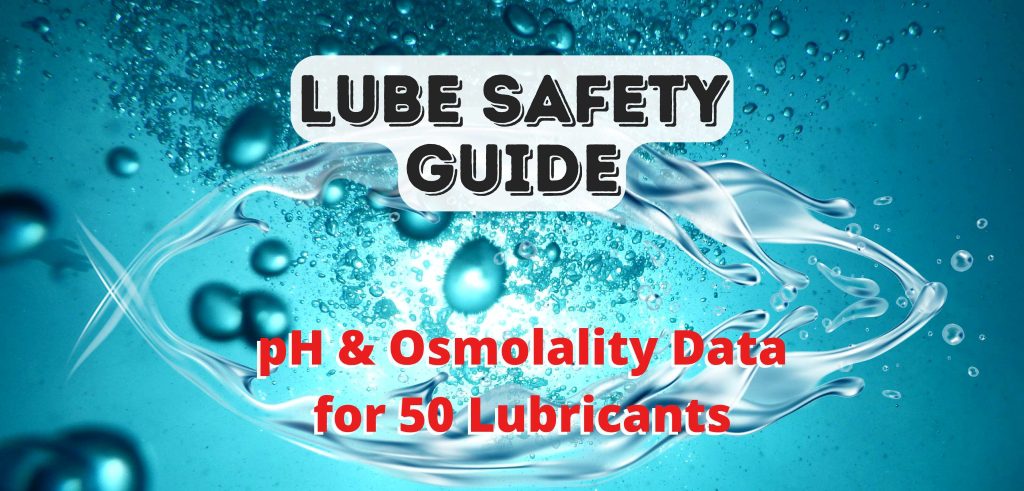
Thank you for posting such a detailed and thorough study! I’m deeply disappointed about Wicked water based lubes– Simply Aqua Jelle had become my new go-to, as the thick texture is ideal for me. The reviews on the individual lubes are also hugely helpful.
thank you for appreciating it!!! And I feel ya about the Wicked Simply. I was really loving the viscosity of it too, after I started using the lineup when Sliquid was having pandemic-related supply problems. Too bad!
This was an excellent and fun article to read! I am shocked with some of the lubes listed that aren’t actually good for the body. Thank you for taking the time to research and provide all this info.
Omigod I’m scared to know about Sliquid Satin now….I just discovered her….it can’t be over already. As someone who suffers from some serious lack of WAP due to meds, I looked into the Pjur Med Repair and I was infuriated by the ingredients. I’m weary of hyaluron in lube’s as well because I know when hyaluronic acid is in skincare, it functions by drawing in any moisture in the surrounding environment, so if you don’t layer an appropriate moisturizer on top it will actually start taking moisture from your skin and doing the opposite of what you wanted.
Ooh, a Sliquid I missed! Satin is so unknown compared to H2O, etc., that I didn’t consider it! Curious how concentrated the plant cellulose in that one is! Will have to see about picking it up to test. (Feel free to donate a few bucks toward Satin’s cost!)
Good for you for doing your research! It’s crazy how much we have to work to get safe products sometimes!
Interesting about hyaluronic acid; it is a humectant, and billed as natural because it’s in lower layers of skin normally; but again, “natural” doesn’t mean “beneficial in all amounts when applied to different human bodies.” The percentage of hyaluronic acid in a lube/cream definitely matters; and now that I’m researching, it turns out that the HA particle size matters too! Added it to my “ingredients of concern” list.
I always hear such good things about Sliquid Sassy but it STINGS so bad for me! I love Sliquid Silk (it’s very multipurpose for me and my boyfriend) but may have to make the switch to one of the hybrids you recommended. Thanks for this post!
Aha, interesting! Thank you for sharing. I have heard of a few Sliquid Sassy reactions; like, at some point years back on Twitter, I read where someone was thinking that the potassium sorbate in Sliquid Sassy was the problem for them. But that likely is not true for you, since both Silk and Sassy have potassium sorbate and citric acid as the preservatives.
Silk has a little high osmolality, but probably won’t be too damaging; You might check out Good Clean Love’s Hybrid and see if it feels any better for you! Let me know your thoughts if you do!
So, months later, I did actually try out the Good Clean Love Hybrid for penetrative sex with my boyfriend and sadly, it stings me even more consistently than Sliquid Sassy. Like, it stings EVERY time it touches my vagina. I’m thinking of trying the GCL Almost Naked next since it doesn’t have glycerin.
wow thank you! any thoughts on the yes waterbased? it’s the most available where i live and also almost half the price of almost naked, but i’ve never seen a review on it…i had a bottle back then as teenager but it was reformulated since then and i’d like a proffesional’s comparison 🙂 i remember it as a bit of clotty jelly texture, like a plain aloe gel would have, not entirely smooth?
Is it safe to buy name brand lube at Amazon?
Thank you so much for doing this research! I’m gutted to hear about Sassy – it’s my current go-to because it’s not as drippy as most water-based lubes.
Do you know if the Good Clean Love lubes are sold anywhere in the UK? I haven’t seen them anywhere and I’m not finding any obvious sources on Google. I’ve tried Yes WB and it’s ok but it’s so drippy I felt like I wasted half the bottle.
As always, well written and incredibly helpful content! I’ll be saving this information for future use! Thanks for sharing your insights with us!
Thank you for this excellent resource! In regards to footnote 12, I would like to point readers to the 2017 presentation, “Treating Vulvovaginal Atrophy/Genitourinary Syndrome of
Menopause: Lubricants, Moisturizers, and Vaginal DHEA,” by Nick Panay. It’s the most relevant and thorough source I’ve found, and it indicates that premenopausal suggestions for osmolality and pH apply to postmenopausal vaginal use as well. But it becomes much more important when your vagina is already prone to be dry with high pH.
I found it doing research because I am currently looking forward to young GSM due to taking testosterone – I was wondering if postmenopausal vaginal lubricant use should be higher pH than premenopausal in order to match the higher pH of postmenopausal vaginas, and the answer is no, vaginal lubricants should still be within the 3.8-4.5 range (the presentation says 3 should be the absolute rock bottom because animal studies have shown pH below 3 is unsafe for vaginal use). My understanding is that postmenopausal higher pH is part of the reason people with GSM tend to be more susceptible to infections, so it’s extra important for us to use lubes with the correct pH since our vaginas are already prone to having high pH. Just in case anyone was wondering. 🙂
I will be bookmarking this post and sharing it every time I see someone with a vaginal lube question!
Hi!! Thank you for reading! I have Edwards & Panay, “Treating…” in my top medical studies list for sure! My first comment on it was: “This literature review has great charts, and really, applies to how lubes affect vaginal tissues at any age.” The numbers they give there are especially helpful for “vaginal moisturizers,” of which I only tested a couple since my main goal for this piece was lubes. (RepHresh does pop up a lot, though, maybe I should add that.)
Thank you for the great discussion of whether *all* people with vaginas should use a lube in that “normal” safe range, 3.8 to 4.5 pH, for premenopausal folks—that’s really good to know!
Be well!!!
Man that sucks about Wicked Simply. That’s my go-to recommendation and what I personally use. I might have to try get some other stuff coz I’m super prone to BV and thrush 🙁
Although out of everything stocked in our store, Wicked is the best of the bad lol
This Is a terrifying and depressing article, seems like there aren’t any safe lubes in my country (and if there are any I have no way to know it). And I can’t order a safe lube from amazon.
I appreciate the info, hope you test more lubes in the future.
Please review Wet Naturals or other lubes of the brand.
I’m interested in doing this; there are several Wet Naturals products, but I’m seeing them out of stock at the moment online at the first 3 retailers listed (I could of course did deeper, maybe someone has them in stock). The second ingredient, PEG, is used independently as a laxative to increase osmotic pressure, so I’d hypothesize it increases osmolality to some degree like propylene glycol; Wet Naturals also has diazolidinyl urea, which is an antimicrobial that can kill bacteria, so right away I know I wouldn’t use it vaginally (where certain Lactobacillus bacteria are crucial for maintaining health) — even though that ingredient is farther down the ingredients list so it’s likely at a low percentage, but still.
Can you please test WaterSlide? It has very few ingredients and has worked really well for my sensitive skin
Hi, sorry this took me so long!!! I got some Waterslide, and the propanediol (which is like propylene glycol lite) is making the osmolality over the recommended limit; it’s measuring in the 2350s mOsm/kg.
I’m super suprised, though, about something that everyone can test at home with a $10 to $15 pH strip purchase: it’s actually alkaline. It’s not acidic.
That’s super weird for a water-based lube, where acidity is one factor that helps stop the lube from “going bad” too soon. Healthy vaginal pH is 3.8 to 4.5, so using a lube over 7.0 is not ideal (though menstrual blood and semen have a similar slightly-alkaline pH). It’s definitely about quantity that’s inside the vagina; I would avoid using WaterSlide in large quantities in general, and especially would recommend skipping it to anyone who has a history of either yeast infection or bacterial vaginosis or HPV.
This is very insightful!!
I recently switched to Slippery Stuff water based and I’ve really liked the consistency and no burning or other reactions no matter how much I use, but I don’t see it on any of these lists. Where does it fall?
It’s on page 3
Slippery Stuff
Osmolality 21 (quite low)
pH 7.0
This guide is so SO helpful and I’m really grateful for all the work you’ve done. I’d be curious about seeing where GoLove’s CBD lube falls under all this; it seems decent but I’d only checked for the three ingredients you mentioned that one should stay away from and they mentioned it’s PH balanced but I’m not sure if that stated on its own is enough/if more information should be provided.
@Felicity I agree! Please do let us know where GoLove CBD Lube falls on your safety rating scale! 🙏🙏🙏
Hi, and thank you for this awesome investigation work!
I’m currently living in France, and I was really interested by Coconu by it looks like it is not sold here or in the EU. Do you know any good alternative to Coconu which I could find here?
Thank you again!
You’re welcome!!! Coconu is sunflower oil + coconut oil first, so look for those two ingredients for sure. If you can’t find that, you might try mixing organic sunflower oil into virgin coconut oil that’s at a warm room temp, so it’s not fully solid but also not fully liquid; somewhere in the vicinity of 24 degrees C.
Do you think you might try/test out The Butters Hygienics Co. lube at some point?
They’re an oil based lubricant that I’ve been really curious about.
https://getthebutters.com/thebuttersprods/thebutterslube
Sure, I tried the Butters about 5 years ago. Very slick. It’s like Coconu in some respects but a little thicker at room temp in the low to mid-70s (F). I prefer Coconu because the squeeze tube is easier; with the Butters, it’s in a jar so you have to get a clean scoop for each use. Also, if ordering in the summer, it will probably melt in the mail due to the higher coconut oil concentration (which I didn’t found happened with Coconu), but with the Butters you stick it in the fridge to firm it back up if you don’t want it to be fully liquid.
There’s nothing that I could test here, just tell you about the consistency; since oil lubes don’t measure for osmolality or pH!
Is there a best practice for cleaning up / out PEO based lubes? I have been using BD’s Clear lube but now I’m scared I’ve harmed myself by doing so.
For anal use, I don’t think there’s any significant proven risk from hypo-osmolal lubricant (like a PEO-base creates), and you shouldn’t fret. There’s just that one study on the hypoosmolal lube on slugs, which hasn’t been repeated and obviously slugs aren’t exactly the same as human mucosal tissues;
For vaginal use, I personally would be wary of continuing to use it especially in large quantity, due to the neutral (not acidic) pH; but if someone has an always-healthy microbiome (hasn’t had any issues with bacterial vaginosis or yeast infection, etc.) and isn’t engaging in any extra risk such as taking multiple new sex partners, then a bit of 7.0 pH shouldn’t be an issue (because menstrual blood is higher pH too, so it’s not a totally unnatural situation). The… adhesiveness of PEO lubes make me wary, but personal situation definitely matters. In any case, if you’ve never felt weird (like burning pain or irritation) after using a PEO-based lube, I wouldn’t worry about it.
Thank you so much for this resource. I am very sensitive and have had many lubes painfully burn when applied and so am scared to try new products. This gives me some confidence that I can find an option that works well for me without having to trial and error on my delicate bits. I noticed Coconu now has a water based formula as well and I was wondering if you had a chance to test ph and osmolality on this one yet? Would love to know results, thank you!
Is it safe to mix silicone lube and coconut oil?
Well, for anal I don’t see any potential danger, but I’m not certain what benefit you’d get from that vs. just using the coconut oil or just the silicone lube.
Hey there! I work in the industry of selling toys and we sell a brand called Pjur med, which is marketed as a made by women for women, German brand, and medical brand that’s intended for people with a lot of sensitivities. I sell lots of the water based ones. Do you have any thoughts on them?
Pjur Med’s first sentence ludicrously states *as if it’s a positive selling point* that the product is made with glycerin. (Pure vegetable glycerin, they say 🙄) Glycerin is never a positive thing when it comes to osmolality, especially as the second ingredient in the ingredients list. (Plus benzyl alcohol as an ingredient in any concentration is concerning.)
And it’s truly a shame that Pjur is big business enough that WowTech includes their glycerin lube as sample packets with We-Vibe products, etc. Crazy that they haven’t realized that anyone who’s looked into lube safely will throw glycerin lube in the garbage.
Hey there, Felicity! Very grateful for this write-up (even though it means I’ll have to throw 80% of my lube away). I’ve in fact shared it with a few redditors when the topic of toys and/or lube comes up.
Would you be willing to apply the scientific method to Boy Butter and share your findings? I’ve been touting it as a good option for anal play, but I’d like to be sure.
Since Boy Butter has both oil and silicone components, it’s not possible to test for osmolality or pH. It does use glycerin as its second ingredient, as an emulsifier. Boy Butter’s oil is listed as hydrogenated, meaning it’s more refined vs. virgin oils. Hydrogenation produces trans fats, correlated with numerous health issues (linking one source on that, but there are a ton). And Boy Butter doesn’t specify what type of “vegetable oils” it uses, anyway, which feels shady. I’m big on less-refined and less-processed for gut microbiome reasons personally, so I figure the same standard for what goes into my mouth should apply to what goes into my ass. Virgin coconut oil / liquid virgin coconut oil, Coconu, and also The Butters are all less processed.
Got it! I appreciate your reply. Is a lube with hydrogenated vegetable oils (i.e. trans fats) as harmful in your rectum as it is in your stomach? If so, then I’ll be bidding farewell to Boy Butter.
Also, which silicone components were you referring to? I didn’t think Boy Butter was a hybrid lube.
Thanks for all this, very informative! It got me looking closer at lubes I’ve tried and it’s been interesting.
Particularly Aquaglide lubes which I’ve found to be pretty good but now I’m getting confused by the ingredients.
The standard Aquaglide ingredients read OK though I see “Vegetable Glycerin” in there:
https://joydivision.de/en/all-products/aquaglide-liquid-250-ml
But where it gets weird is their “Sensitive” Lube:
https://joydivision.de/en/all-products/aquaglide-sensitive-125-ml
Based on what I’ve just learnt that ingredient list seems off the rails for what is apparently the sensitive version. Compared to the standard one we now have “Propylene Glycol” and “Pentylene Glycol”.
They also have the Anal version of their standard lube which has the same ingredients but I’m now guessing is a higher concentration. I had been using that for Vaginal use but I think I’ll stop that now.
Another Lube that’s popular in my neck of the woods is the “Wet Stuff” brand, Wet Stuff Gold particularly. On their website they have a chart comparing all their lubes:
https://www.gelworks.com.au/quick-ref
They give “Gold” a tick for PH and a tick for Low-Irritant but looking at the ingredients list I found here:
https://sexualwellbeing.org.nz/shop/products/lubricants/wet-stuff-lubricant-gold/
Glycerine, propylene glycol, purified water, hydroxy ethyl cellulose, lambda carrageenan, methyl and ethyl hydroxybenzoate, phenoxyethanol, emulsifying wax, sodium lactate, alpha tocopherol acetate (Vit E)edta
It looks like we have a lot of nasties! I switched off Wet Stuff Gold because I was trying to find something longer lasting and found other brands also irritated my partner less. Now I know why!
Very eye-opening overall, a lot of my personal experiences make sense now. Unfortunately I can’t find good clean love in my area but I’ll be getting a bottle of Sliquid H20!
I really appreciate this list! Ever since reading it, Good Clean Love is the only lube I’ve bought. But now that I’m in a monogamous relationship, my only use for water based lube is with my own TPE strokers… I’ve began to wonder if my lube choices should change. I’ve been using the standard GCL on my own (since it’s cheaper) and the vanilla GCL when my girlfriend uses a toy on me (since it tastes better), but I’m not sure if it’s the safest option for my penis.
Do you have any interest in writing about the safest lubes for penises? I understand you’re a cis woman and penis toys/paraphernalia aren’t the focus of your blog, but you do the most in-depth lube analysis I’ve seen and I’d be *very* grateful for your take! 😀
Great article! This has been the number 1 resource I link to people when we talk about lubes. Thanks a lot for writing it.
got a question though. What would you reccomend for anal *size/width/depth play*?
Me and my partner don’t particularly like coconut oil or the couple silicone lubes we’ve tried. They’re nowhere near slick enough, especially for width play. And additionally, one of us gets the nastiest farts after using coconut oil as lube.
PEO-based seems like the best tool for the job, but at the same time, we notice the effects of it’s hypo-osmolality during long sessions. We try to stop when we notice the effects, and we do a douche after a long session to dilute the lube a lot to reduce the effects, but I have the sneaking suspicion that by the time we notice the effects (“stuff becomes wattery and not from adding extra lube, I assume that’s the lube absorbing water from the GI lining”), the cells are already damaged, we’re just reducing further damage.
Thank you!! I honestly think we’re still in the process of coming out of the metaphorical Dark Ages of lubricant safety, so I hope more options with better ingredients will be forthcoming in the next 5 years!
What coconut oil are you using? Just checking that it’s extra virgin / unrefined, since refined coconut oil has trans-fats which cause all kinds of issues.
It is of course possible to have a particular sensitivity to coconut, I suppose like with any plant. I think it feels great and believe this is a fairly uncommon issue, but clearly possible.
Have you tried Coconu? Despite the name, it’s actually sunflower seed oil as the first ingredient. You could also try pure sunflower seed oil and/or or play with a good organic shea butter possibly mixed with other natural oils.
Are you certain you’re applying the silicone lube far enough inside? I can see how that’d be more difficult for real depth play, but a lube shooter should work well for width stretching in the rectum.
We have tried extra virgin cold pressed coconut oil.
And while we don’t have a lube shooter, we do use a ~3″ syringe to insert lube (I only just now discovered that a lube shooter is more than twice that length :D)
I’ll give Coconu a try (Or just mix sunflower seed with coconut oil) and report back.
I have another question. You have warned against trans fats a couple times in the comments. But considering that fats get absorbed in the small intestine, would trans fats even be an issue for anal?